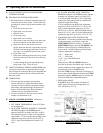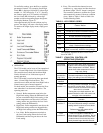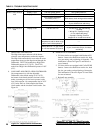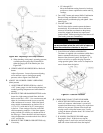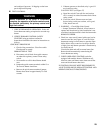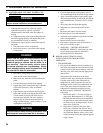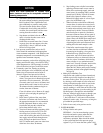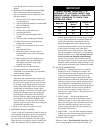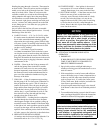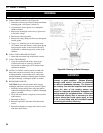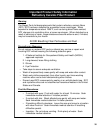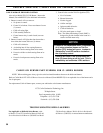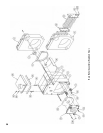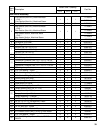
32
water should come out of all air vents when
opened.
b. BOILING OUT OF BOILER AND SYSTEM.
The oil and grease which accumulate in a
new hot water boiler can be washed out in the
following manner:
i. Remove relief valve using extreme care to
avoid damaging it.
ii. Add an appropriate amount of recommended
boil out compound.
iii. Replace relief valve.
iv. Fill the entire system with water.
v. Start ring the boiler.
vi. Circulate the water through the entire
system.
vii. Vent the system, including the radiation.
viii. Allow boiler water to reach operating
temperature, if possible.
ix. Continue to circulate the water for a few
hours.
x. Stop ring the boiler.
xi. Drain the system in a manner and to a
location that hot water can be discharged
with safety.
xii. Remove plugs from all available returns
and wash the water side of the boiler as
thoroughly as possible, using a high-
pressure water stream.
xiii. Rell the system with fresh water.
c. Add appropriate boiler water treatment
compounds as recommended by your qualied
water treatment company.
d. Make pH or Alkalinity Test.
After boiler and system have been cleaned and
relled as previously described, test the pH of
the water in the system. This can easily be done
by drawing a small sample of boiler water and
testing with hydrion paper which is used in the
same manner as litmus paper, except it gives
specic readings. A color chart on the side of the
small hydrion dispenser gives the reading pH.
Hydrion paper is inexpensive and obtainable
from any chemical supply house or through your
local druggist. The pH should be higher than
7 but lower than 11. Add some of the washout
chemical (caustic soda), if necessary, to bring the
PH within the specied range.
e. Boiler is now ready to be put into service.
3. EXCESSIVE MAKE-UP WATER
A leaky system will increase the volume of make-up
water supplied to the boiler, which can signicantly
shorten the life of the boiler. Entrained in make-
up water are dissolved minerals, salts and oxygen.
When the fresh, cool make-up water is heated in the
boiler, the minerals fall out as sediment, the salts
coat the inside of the boiler, and the oxygen escapes
as a gas. The accumulation of sediment eventually
isolates the water from contacting the cast iron.
When this happens the cast iron in that area gets
extremely hot and eventually cracks. The presence
of free oxygen or chloride salts in the boiler
corrodes the cast iron from the inside. More make-
up water and higher concentrations of contaminants
damage the boiler sooner. Our warranty does not
cover corrosion and sediment-related damage.
Clearly it is in everyone’s best interest to prevent
this type of failure. You can do your part by ensuring
that your system is leak-free, keeping leakage to less
than 2 percent of the total water volume each month.
C. HINTS ON COMBUSTION
1. NOZZLES — Although the nozzle is a relatively
inexpensive device, its function is critical to the
successful operation of the oil burner. The selection
of the nozzle supplied with the CL boiler is the
result of extensive testing to obtain the best ame
shape and efcient combustion. Other brands of the
same spray angle and spray pattern may be used but
may not perform at the expected level of CO
2
and
smoke. Nozzles are delicate and should be protected
from dirt and abuse. Nozzles are mass-produced
and can vary from sample to sample. For all of
those reasons a spare nozzle is a desirable item for a
serviceman to have.
2. FUEL LEAKS — Any fuel leak between the
pump and the nozzle will be detrimental to good
combustion results. Look for wet surfaces in the air
tube, under the ignitor, and around the air inlet. Any
such leaks should be repaired as they may cause
erratic burning of the fuel and in the extreme case
may become a re hazard.
3. AIR LEAKS — Any such leaks should be repaired,
as they may cause erratic burning of the fuel and in
extreme cases may become a re hazard.
SUCTION LINE LEAKS -
Whatever it takes, The Oil Must Be Free of Air. This
can be a tough problem , but it must be resolved. Try
IMPORTANT
IF, DURING NORMAL OPERATION, IT IS
NECESSARY TO ADD MORE WATER THAN
INDICATED BELOW, CONSULT A QUALIFIED
SERVICE TECHNICIAN TO CHECK YOUR
SYSTEM FOR LEAKS.
Model No.
Gallons Per
Month
Gallons Per
Year
CL3 0.3 4
CL
4 0.4 5
CL5 0.5 6



